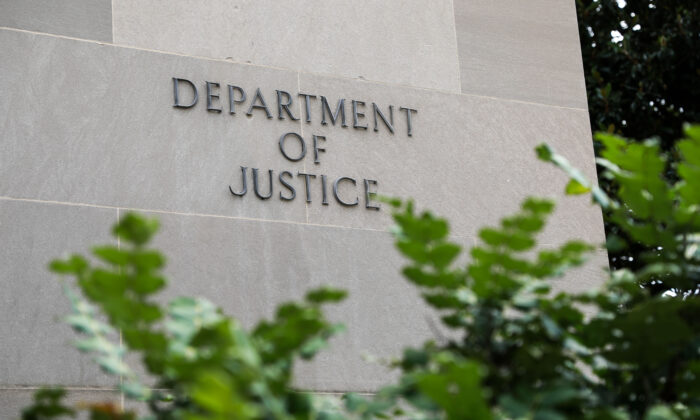The Department of Justice on April 16 asked the Supreme Court to formally block lower court rulings that prevented President Donald Trump from firing members of independent labor boards.
Acting on behalf of the high court, Chief Justice John Roberts on April 9 temporarily halted the orders by two Washington-based federal judges that blocked the president’s firings of Cathy Harris from the Merit Systems Protection Board (MSPB) and Gwynne Wilcox from the National Labor Relations Board (NLRB) before their terms expire.
The order issued by Roberts, called an administrative stay, gave the justices more time to consider the Trump administration’s emergency application seeking a block. The stay was granted on April 9, hours after the administration requested it. Roberts did not explain his ruling.
Although Article 2 of the Constitution assigns all executive power to the president alone, “the district court held otherwise,” Solicitor General D. John Sauer wrote in the new filing.
“It ruled that the President must have cause to fire the leaders of executive agencies that dictate the terms of private employment relationships and control aspects of federal employment, and it compelled the President to continue entrusting significant executive power to principal executive officers whom he considers unfit to wield it.
“Those decisions were gravely erroneous, and they should be stayed.”
Reinstating principal officers is “a grave affront to the President’s ability to run the Executive Branch,” Sauer wrote.
“Until this Administration, no federal court had issued an order reinstating a principal executive officer fired by the President,” he wrote.
In the April 9 application, Sauer argued that the president “should not be forced to delegate his executive power to agency heads who are demonstrably at odds with the Administration’s policy objectives for a single day—much less for the months that it would likely take for the courts to resolve this litigation.”
Wilcox was appointed to the NLRB by President Joe Biden in 2021 after Senate confirmation. She was reappointed in 2023.
Under the National Labor Relations Act, the NLRB hears complaints about employers engaged in unfair labor practices.
Trump ordered her fired on Jan. 27 and notified her by email.
According to the application, the email said the NLRB was “not presently fulfilling its responsibility to the American people,” and that it would be in a better position to comply with administration objectives “with personnel of [Trump’s] own selection.”
The email said Wilcox “had not, in [Trump’s] judgment, been operating in a manner consistent with the objectives of [his] administration.”
Wilcox sued in federal district court in Washington and secured a summary judgment on March 6 that said her removal was “unlawful” and that she “remains a member” of the NLRB who can be removed by the president only on grounds provided in the statute governing the board.
That court rejected the administration’s argument that the tenure protection provided by the statute violates Article 2 of the Constitution, which spells out the president’s powers.
The district court held that it was bound by Humphrey’s Executor v. United States (1935) in which the Supreme Court determined that President Franklin Roosevelt acted unlawfully when he terminated the head of the Federal Trade Commission, a so-called independent executive agency, without cause.
The executive branch is not “strictly unitary,” and the president’s power to remove officials “has never been viewed as unrestricted,” the district court held.
Harris, a member of the MSPB, was appointed by Biden in 2022 after Senate confirmation. In 2024, Biden elevated her to the chairmanship of the board.
She was fired by Trump on Feb. 10. The White House notified her by email that her position was “terminated, effective immediately.”
The board reviews rules handed down by the Office of Personnel Management, which oversees federal employees. The board enforces the government’s “merit system principles,” which are “designed to ensure fair and open recruitment and competition and employment practices free of political influence or other nonmerit factors,” the Office of Personnel Management website states.
Harris sued, and on Feb. 18, the federal district court issued a temporary restraining order restoring her employment at the board.
On March 4, the district court granted Harris summary judgment, reinstating her as a member of the board, but not as chairman, according to the application.
A motions panel of the U.S. Court of Appeals for the District of Columbia Circuit then temporarily stayed the lower court rulings, pending appeal. Days later, a divided full circuit lifted the stay issued by the panel, the application said.
In the application, the government had argued that Article 2 gives the president authority “to remove, at will, members of multimember boards that wield substantial executive power, such as the NLRB and MSPB.”
Supreme Court precedents “also establish that district courts lack the power to issue injunctions or declaratory judgments countermanding the President’s removal of executive officers,” the application stated.
Meanwhile, on April 15, Harris and Wilcox filed responses to the application in which they argued that they should be reinstated.
Harris argued that the government is moving too quickly, seeking “a blitzkrieg-to-judgment” by asking the Supreme Court “to overturn a century of practice and precedent—and invalidate the structure of numerous agencies” without having a full briefing and oral argument in the case.
She urged the high court to deny the application and permit the D.C. Circuit to hold an expedited oral argument in the case on May 16.
Wilcox said in her brief that for almost a century, “no prior administration has attempted to remove a member of the National Labor Relations Board.”
“The Executive [branch] has no legitimate interest in completely shutting down an adjudicatory body created by Congress,” the brief states.
Removing Wilcox would deprive the board of a quorum of three members, halting the appeals process it carries out.
The Supreme Court could act on the president’s emergency application at any time.
This article by Matthew Vadum appeared April 16, 2025, in The Epoch Times. It was updated April 17, 2025.


